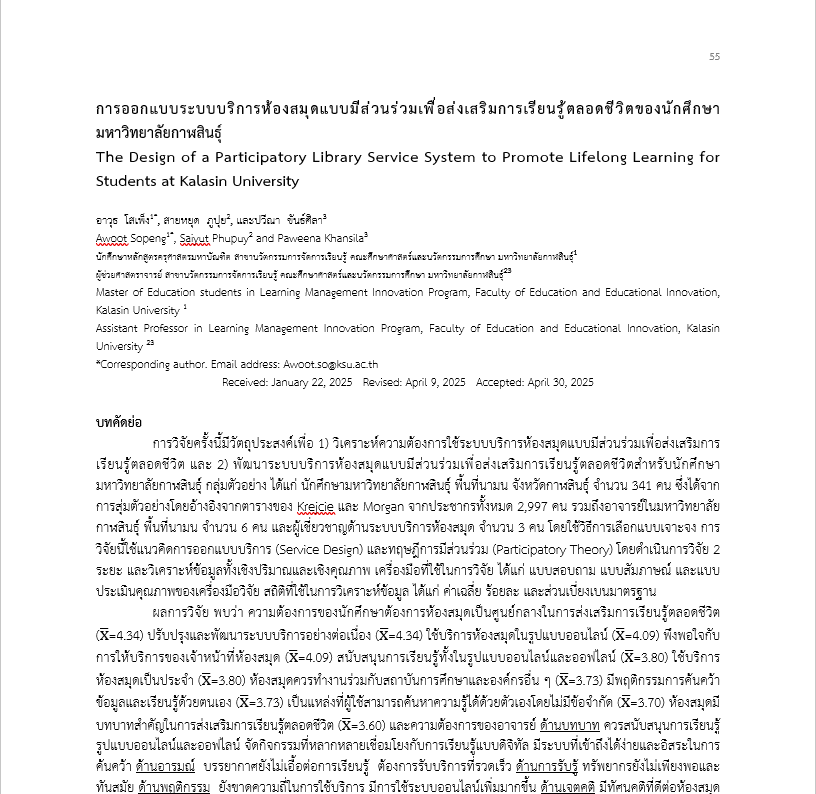The Design of a Participatory Library Service System to Promote Lifelong Learning for Students at Kalasin University
Main Article Content
Abstract
The purposes of this research were to 1) analyze the demand for a participatory library service system to promote lifelong learning, and 2) develop a participatory library service system to promote lifelong learning for Kalasin University students. The sample consisted of 341 undergraduate students from Kalasin University, Namon Campus, selected through simple random sampling based on Krejcie & Morgan’s sample size table from a total population of 2,997 students. Additionally, purposive sampling was employed to select 6 university instructors and 3 experts in library service systems. This research was grounded in the concepts of Service Design and Participatory Theory and was conducted in two phases using both quantitative and qualitative methods. The research instruments included questionnaires, interview forms, and an instrument quality assessment form. Data were analyzed using descriptive statistics, including mean, percentage, and standard deviation.
The research findings revealed that students required the library to serve as a central hub for promoting lifelong learning ( =4.34), continuous improvement and development of library services (
=4.34), and online library services (
=4.09). They expressed satisfaction with the services provided by library staff (
=4.09), desired support for both online and offline learning (
=3.80), and regular library usage (
=3.80). They also believed the library should collaborate with educational institutions and other organizations (
=3.73), demonstrated self-directed learning behavior (
=3.73), and viewed the library as a place to seek knowledge without limitations (
=3.70). The library was vital in promoting lifelong learning (
=3.60). Focusing on the needs of lecturers, the library's role should include supporting both online and offline learning, organizing diverse activities linked to digital learning, and providing easy and flexible access to resources. In terms of atmosphere, the current environment was not conducive to learning, and there was a need for faster service delivery. Concerning awareness, resources were insufficient and outdated. There was a low frequency of service use for behavior, with increased online system utilization. In terms of attitudes, lecturers positively perceived the library as a place that fosters learning by incorporating new technologies, online services, and adaptations to user needs and behaviors. The developed library service system, KSU Lifelong Learning for Library, consisted of seven knowledge modules with guides for users and librarians. The system was implemented as a website link and QR code, allowing users to access it anytime and anywhere with an internet connection. The quality assessment of the KSU Lifelong Learning for Library service system indicated high suitability, with an average score of 4.12, demonstrating its practical applicability.
Article Details

This work is licensed under a Creative Commons Attribution-NonCommercial-NoDerivatives 4.0 International License.
บทความที่ได้รับการตีพิมพ์เป็นลิขสิทธิ์ของวารสารครุศาสตร์ คณะครุศาสตร์ มหาวิทยาลัยนครพนม ข้อความที่ปรากฏในบทความแต่ละเรื่องในวารสารครุศาสตร์เล่มนี้เป็นความคิดเห็นส่วนตัวของผู้เขียนแต่ละท่านไม่เกี่ยวข้องกับมหาวิทยาลัยนครพนม และคณาจารย์ท่านอื่น ๆ ในมหาวิทยาลัยฯ แต่อย่างใด ความรับผิดชอบองค์ประกอบทั้งหมดของบทความแต่ละเรื่องเป็นของผู้เขียนแต่ละท่าน หากมีความผิดพลาดใด ๆ ผู้เขียนแต่ละท่านจะรับผิดชอบบทความของตนเองแต่ผู้เดียว
References
งานวิทยบริการและเทคโนโลยีการศึกษา มหาวิทยาลัยกาฬสินธุ์. (2558). สรุปรายงานผลการดำเนินงานการใช้บริการห้องสมุดงานวิทยบริการและเทคโนโลยีการศึกษา ประจำปีงบประมาณ 2558. กาฬสินธุ์: มหาวิทยาลัยกาฬสินธุ์.
ชนันนา รอดสุทธิ. (2561). เทคนิคการมีส่วนร่วมเพื่อสร้าง“ประสบการณ์ผู้ใช้” ในงานบริการห้องสมุดยุค 4.0. วารสารบรรณศาสตร์ มศว, 11(1), 209-219.
บุญชม ศรีสะอาด. (2560). การวิจัยเบื้องต้น (พิมพ์ครั้งที่ 10). กรุงเทพฯ: สุวีริยาสาส์น.
ปริญญ์ ขวัญเรียง, ก้องกิดากร บุญช่วย. (2567, มกราคม-มิถุนายน). ปัจจัยที่มีผลต่อความสาเร็จในการใช้บริการของผู้ใช้ห้องสมุดมหาวิทยาลัยในการกับของรัฐในจังหวัดภาคใต้. วารสารห้องสมุด, 68(1), หน้า 38-56.
มหาวิทยาลัยกาฬสินธุ์. (2564). แผนพัฒนามหาวิทยาลัยกาฬสินธุ์ ระยะ 5 ปี (พ.ศ.2564-2568) วาระแรก 3 ปี. กาฬสินธุ์: มหาวิทยาลัยกาฬสินธุ์.
ศูนย์สร้างสรรค์งานออกแบบ (TCDC). (2557). Service Design Workbook : คู่มือการออกแบบบริการ กรุงเทพฯ: ศูนย์สร้างสรรค์งานออกแบบ.
สุวิชา ศรีวิชัย, ปิยะ พละปัญญา, อเสกข์ เพ็ชรเฟื่อง. (2567). การศึกษาและพัฒนารูปแบบการให้บริการทรัพยากรสารสนเทศ โดยใช้เทคโนโลยีโลกเสมือนจริงแบบมีส่วนร่วม. PULINET Journal, 11)1), หน้า 176-188.
สุวิมล ว่องวาณิช. (2563). การวิจัยออกแบบทางการศึกษา. กรุงเทพฯ: จุฬาลงกรณ์มหาวิทยาลัย.
สำนักงานคณะกรรมการการอุดมศึกษา. (2561). แผนอุดมศึกษาระยะยาว 20 ปี พ.ศ. 2561 – 2580. กรุงเทพฯ : สำนักงานคณะกรรมการการอุดมศึกษา.
Cohen, J. M., & Uphoff, N. T. (1977). Participation’s place in rural development: Seeking clarity through specificity. World Development, 6(3), 213–229.
Krejcie, R.V., & D.W. Morgan. (1970). “Determining Sample Size for Research Activities”. Educational and Psychological Measurement. 30(3) : 607 – 610.
UNESCO-IBE. (2016). Lifelong learning. International Bureau of Education. Retrieved December5, http://www.ibe.unesco.org/en/glossary-curriculum-terminology/l/lifelong-learning


